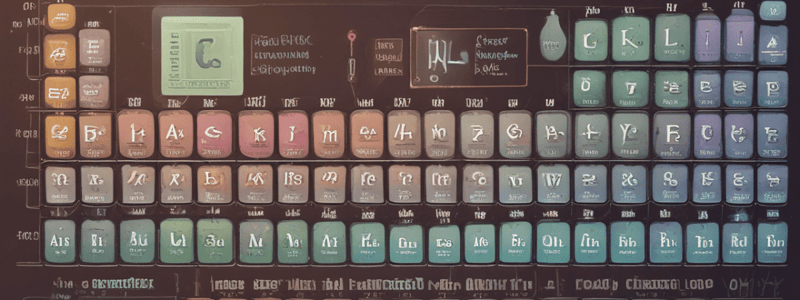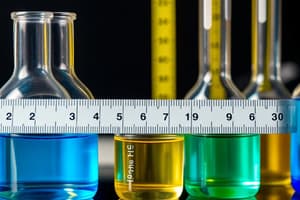Podcast
Questions and Answers
What is the charge of a cation?
What is the charge of a cation?
- Neutral
- Negative
- Positive (correct)
- Opposite
Where are non-metals typically located on the periodic table?
Where are non-metals typically located on the periodic table?
- Right side (correct)
- Bottom side
- Top side
- Left side
How is millimetres converted into micrometres?
How is millimetres converted into micrometres?
- +1000
- -1000
- * 1000 (correct)
- / 1000
What does the period number of elements in the periodic table indicate?
What does the period number of elements in the periodic table indicate?
What information does the group number of elements in the periodic table provide?
What information does the group number of elements in the periodic table provide?
In which direction do you move on the periodic table to go from metals to non-metals?
In which direction do you move on the periodic table to go from metals to non-metals?
What is the relationship between converting micrometres to nanometres and converting nanometres to picometres?
What is the relationship between converting micrometres to nanometres and converting nanometres to picometres?
What characteristic of an element can be determined based on its group number in the periodic table?
What characteristic of an element can be determined based on its group number in the periodic table?
What happens to the charge when an atom becomes an anion?
What happens to the charge when an atom becomes an anion?
How does the number of shells in an element relate to its position on the periodic table?
How does the number of shells in an element relate to its position on the periodic table?
Flashcards are hidden until you start studying
Study Notes
Ions
- A cation is a positively charged atom.
- An anion is a negatively charged atom.
Periodic Table
- Metals are located on the left side of the periodic table.
- Non-metals are located on the right side of the periodic table.
Unit Conversions
- To convert metres to millimetres, multiply by 1000.
- To convert millimetres to micrometres, multiply by 1000.
- To convert micrometres to nanometres, multiply by 1000.
- To convert nanometres to picometres, multiply by 1000.
Periodic Table Information
- The group number of an element in the periodic table indicates the number of outer shell electrons.
- The period number of an element in the periodic table indicates the number of shells.
Studying That Suits You
Use AI to generate personalized quizzes and flashcards to suit your learning preferences.



